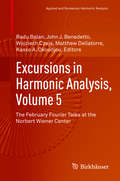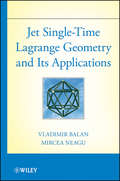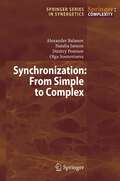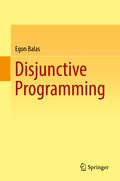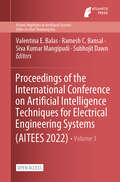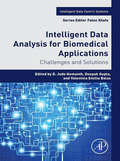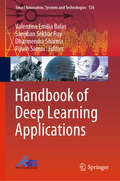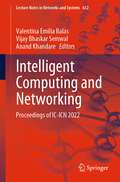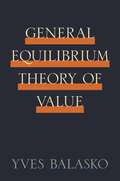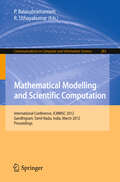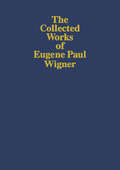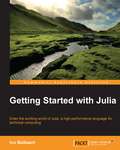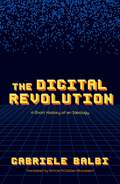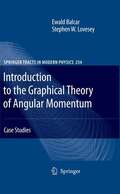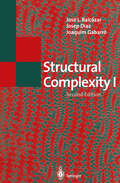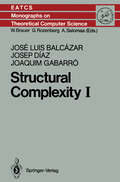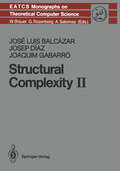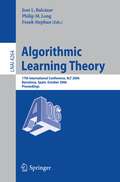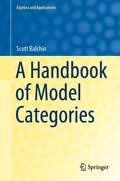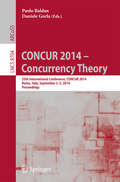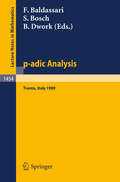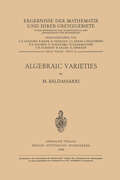- Table View
- List View
Excursions in Harmonic Analysis, Volume 5: The February Fourier Talks at the Norbert Wiener Center (Applied and Numerical Harmonic Analysis)
by Radu Balan John J. Benedetto Wojciech Czaja Matthew Dellatorre Kasso A. OkoudjouThis volume consists of contributions spanning a wide spectrum of harmonic analysis and its applications written by speakers at the February Fourier Talks from 2002 – 2016. Containing cutting-edge results by an impressive array of mathematicians, engineers, and scientists in academia, industry and government, it will be an excellent reference for graduate students, researchers, and professionals in pure and applied mathematics, physics, and engineering. Topics covered include:Theoretical harmonic analysisImage and signal processingQuantizationAlgorithms and representationsThe February Fourier Talks are held annually at the Norbert Wiener Center for Harmonic Analysis and Applications. Located at the University of Maryland, College Park, the Norbert Wiener Center provides a state-of- the-art research venue for the broad emerging area of mathematical engineering.
Jet Single-Time Lagrange Geometry and Its Applications
by Vladimir Balan Mircea NeaguDevelops the theory of jet single-time Lagrange geometry and presents modern-day applications Jet Single-Time Lagrange Geometry and Its Applications guides readers through the advantages of jet single-time Lagrange geometry for geometrical modeling. With comprehensive chapters that outline topics ranging in complexity from basic to advanced, the book explores current and emerging applications across a broad range of fields, including mathematics, theoretical and atmospheric physics, economics, and theoretical biology. The authors begin by presenting basic theoretical concepts that serve as the foundation for understanding how and why the discussed theory works. Subusequent chapters compare the geometrical and physical aspects of jet relativistic time-dependent Lagrange geometry to the classical time-dependent Lagrange geometry. A collection of jet geometrical objects are also examined such as d-tensors, relativistic time-dependent semisprays, harmonic curves, and nonlinear connections. Numerous applications, including the gravitational theory developed by both the Berwald-Moór metric and the Chernov metric, are also presented. Throughout the book, the authors offer numerous examples that illustrate how the theory is put into practice, and they also present numerous applications in which the solutions of first-order ordinary differential equation systems are regarded as harmonic curves on 1-jet spaces. In addition, numerous opportunities are provided for readers to gain skill in applying jet single-time Lagrange geometry to solve a wide range of problems. Extensively classroom-tested to ensure an accessible presentation, Jet Single-Time Lagrange Geometry and Its Applications is an excellent book for courses on differential geometry, relativity theory, and mathematical models at the graduate level. The book also serves as an excellent reference for researchers, professionals, and academics in physics, biology, mathematics, and economics who would like to learn more about model-providing geometric structures.
Synchronization: From Simple to Complex (Springer Series in Synergetics)
by Alexander Balanov Natalia Janson Dmitry Postnov Olga SosnovtsevaThis fascinating work is devoted to the fundamental phenomenon in physics – synchronization that occurs in coupled non-linear dissipative oscillators. Examples of such systems range from mechanical clocks to population dynamics, from the human heart to neural networks. The main purpose of this book is to demonstrate that the complexity of synchronous patterns of real oscillating systems can be described in the framework of the general approach, and the authors study this phenomenon as applied to oscillations of different types, such as those with periodic, chaotic, noisy and noise-induced nature.
Der Wille zur Freiheit: Eine gefährliche Reise durch Faschismus und Kommunismus
by Egon BalasDer berühmter Mathematiker Egon Balas nimmt seine Leser mit auf eine erstaunliche Lebensreise: Sie erfahren von großem Mut, grenzenlosem Optimismus und von dem Leid, das Balas auf seinem Weg von Transsilvanien nach Pennsylvania begleitete. Egon Balas wurde 1922 als Sohn ungarisch-jüdischer Eltern geboren, ein Großteil seiner Familie wurde zwischen 1942–1944 ermordet. Nach dem 2. Weltkrieg geriet er in Opposition zum stalinistischen Regime in Rumänien und emigrierte 1966 in die USA. Balas gilt als einer der Pioniere der mathematischen Optimierung.
Disjunctive Programming
by Egon BalasDisjunctive Programming is a technique and a discipline initiated by the author in the early 1970's, which has become a central tool for solving nonconvex optimization problems like pure or mixed integer programs, through convexification (cutting plane) procedures combined with enumeration. It has played a major role in the revolution in the state of the art of Integer Programming that took place roughly during the period 1990-2010. The main benefit that the reader may acquire from reading this book is a deeper understanding of the theoretical underpinnings and of the applications potential of disjunctive programming, which range from more efficient problem formulation to enhanced modeling capability and improved solution methods for integer and combinatorial optimization. Egon Balas is University Professor and Lord Professor of Operations Research at Carnegie Mellon University's Tepper School of Business.
Proceedings of the International Conference on Artificial Intelligence Techniques for Electrical Engineering Systems (Atlantis Highlights in Intelligent Systems #3)
by Valentina E. Balas Ramesh C. Bansal Siva Kumar Mangipudi Subhojit DawnThis is an open access book. The focus of the conference is to provide a unique platform for exchange of ideas and synergy among researchers, academicians and industrial experts across the globe belonging to emerging electrical engineering domains. It also provides a premier platform for the people to present and discuss the most recent innovations and solutions in solving complex and challenging problems related to intelligent electrical engineering systems. Such a blend of various research-oriented minds will lead to productive results and further advancements in electrical engineering research.The book invites submission of novel, recent area of innovation and previously unpublished research work/idea in the field of modern applications of artificial intelligence techniques to electrical engineering systems. The applications of artificial intelligence related to various fields of electrical engineering are mentioned in the conference tracks. The conference is meant to discuss the challenges and applications of latest evolutionary computing techniques, neural networks, fuzzy logic, machine learning and data analytics in the fields of power systems, power electronics, robotics, automation, instrumentation, control systems, mechatronics and photonics. It provides a platform to the students, researchers, scientists, faculty members, professionals and practitioners to interact, present and get innovative ideas in the field of electrical engineering. As a part of AITEES-2022, many keynote sessions are planned to enhance the research and innovation skills of participants. Eminent professors from academic institutions and world renowned industrial experts from India and abroad will deliver keynote sessions.
Intelligent Data Analysis for Biomedical Applications: Challenges and Solutions (Intelligent Data-Centric Systems: Sensor Collected Intelligence)
by Valentina Emilia Balas Deepak Gupta Jude D. HemanthIntelligent Data Analysis for Biomedical Applications: Challenges and Solutions presents specialized statistical, pattern recognition, machine learning, data abstraction and visualization tools for the analysis of data and discovery of mechanisms that create data. It provides computational methods and tools for intelligent data analysis, with an emphasis on problem-solving relating to automated data collection, such as computer-based patient records, data warehousing tools, intelligent alarming, effective and efficient monitoring, and more. This book provides useful references for educational institutions, industry professionals, researchers, scientists, engineers and practitioners interested in intelligent data analysis, knowledge discovery, and decision support in databases.Provides the methods and tools necessary for intelligent data analysis and gives solutions to problems resulting from automated data collectionContains an analysis of medical databases to provide diagnostic expert systemsAddresses the integration of intelligent data analysis techniques within biomedical information systems
Handbook of Deep Learning Applications (Smart Innovation, Systems and Technologies #136)
by Valentina Emilia Balas Sanjiban Sekhar Roy Dharmendra Sharma Pijush SamuiThis book presents a broad range of deep-learning applications related to vision, natural language processing, gene expression, arbitrary object recognition, driverless cars, semantic image segmentation, deep visual residual abstraction, brain–computer interfaces, big data processing, hierarchical deep learning networks as game-playing artefacts using regret matching, and building GPU-accelerated deep learning frameworks. Deep learning, an advanced level of machine learning technique that combines class of learning algorithms with the use of many layers of nonlinear units, has gained considerable attention in recent times. Unlike other books on the market, this volume addresses the challenges of deep learning implementation, computation time, and the complexity of reasoning and modeling different type of data. As such, it is a valuable and comprehensive resource for engineers, researchers, graduate students and Ph.D. scholars.
Intelligent Computing and Networking: Proceedings of IC-ICN 2022 (Lecture Notes in Networks and Systems #632)
by Valentina Emilia Balas Vijay Bhaskar Semwal Anand KhandareThis book gathers high-quality peer-reviewed research papers presented at the International Conference on Intelligent Computing and Networking (IC-ICN 2022), organized by the Computer Department, Thakur College of Engineering and Technology, in Mumbai, Maharashtra, India, on February 25–26, 2022. The book includes innovative and novel papers in the areas of intelligent computing, artificial intelligence, machine learning, deep learning, fuzzy logic, natural language processing, human–machine interaction, big data mining, data science and mining, applications of intelligent systems in healthcare, finance, agriculture and manufacturing, high-performance computing, computer networking, sensor and wireless networks, Internet of Things (IoT), software-defined networks, cryptography, mobile computing, digital forensics and blockchain technology.
General Equilibrium Theory of Value
by Yves BalaskoThe concept of general equilibrium, one of the central components of economic theory, explains the behavior of supply, demand, and prices by showing that supply and demand exist in balance through pricing mechanisms. The mathematical tools and properties for this theory have developed over time to accommodate and incorporate developments in economic theory, from multiple markets and economic agents to theories of production. Yves Balasko offers an extensive, up-to-date look at the standard theory of general equilibrium, to which he has been a major contributor. This book explains how the equilibrium manifold approach can be usefully applied to the general equilibrium model, from basic consumer theory and exchange economies to models with private ownership of production. Balasko examines properties of the standard general equilibrium model that are beyond traditional existence and optimality. He applies the theory of smooth manifolds and mappings to the multiplicity of equilibrium solutions and related discontinuities of market prices. The economic concepts and differential topology methods presented in this book are accessible, clear, and relevant, and no prior knowledge of economic theory is necessary. General Equilibrium Theory of Value offers a comprehensive foundation for the most current models of economic theory and is ideally suited for graduate economics students, advanced undergraduates in mathematics, and researchers in the field.
General Equilibrium Theory of Value
by Yves BalaskoThe concept of general equilibrium, one of the central components of economic theory, explains the behavior of supply, demand, and prices by showing that supply and demand exist in balance through pricing mechanisms. The mathematical tools and properties for this theory have developed over time to accommodate and incorporate developments in economic theory, from multiple markets and economic agents to theories of production. Yves Balasko offers an extensive, up-to-date look at the standard theory of general equilibrium, to which he has been a major contributor. This book explains how the equilibrium manifold approach can be usefully applied to the general equilibrium model, from basic consumer theory and exchange economies to models with private ownership of production. Balasko examines properties of the standard general equilibrium model that are beyond traditional existence and optimality. He applies the theory of smooth manifolds and mappings to the multiplicity of equilibrium solutions and related discontinuities of market prices. The economic concepts and differential topology methods presented in this book are accessible, clear, and relevant, and no prior knowledge of economic theory is necessary. General Equilibrium Theory of Value offers a comprehensive foundation for the most current models of economic theory and is ideally suited for graduate economics students, advanced undergraduates in mathematics, and researchers in the field.
Mathematical Modelling and Scientific Computation: International Conference, ICMMSC 2012, Gandhigram, Tamil Nadu, India, March 16-18, 2012 (Communications in Computer and Information Science #283)
by P. Balasubramaniam R. UthayakumarThis book constitutes the refereed proceedings of the International Conference on Mathematical Modelling and Scientific Intelligence, ICMMSC 2012, Gandhigram, Tamil Nadu, India, in March 2012. The 62 revised full papers presented were carefully reviewed and selected from 332 submissions. The papers are organized in two topical sections on mathematical modelling and on scientific computation.
Part I: Physical Chemistry. Part II: Solid State Physics (The Collected Works #A / 4)
by N. Balazs W. KohnThe fourth volume of the Collected Works is devoted to Wigners contribution to physical chemistry, statistical mechanics and solid-state physics. One corner stone was his introduction of what is now called the Wigner function, while his paper on adiabatic perturbations foreshadowed later work on Berry phases. Although few in number, Wigners articles on solid-state physics laid the foundations for the modern theory of the electronic structure of metals.
Getting Started with Julia
by Ivo BalbaertThis book is for you if you are a data scientist or working on any technical or scientific computation projects. The book assumes you have a basic working knowledge of high-level dynamic languages such as MATLAB, R, Python, or Ruby.
The Digital Revolution: A Short History of an Ideology
by Gabriele Balbi'A must-read to anyone interested in the digital world.' - Valérie Schafer, Center for Contemporary and Digital History, University of Luxembourg A concise history of the digital revolution and the lore, rhetoric, and debates that surround it. The Digital Revolution aims to tell a story, one of the most powerful ideologies of recent decades: that digitalization constitutes a revolution, a break with the past, a radical change for the human beings who are living through it. The book aims to investigate the origins of this idea, how it evolved, which other past revolutions consciously or unconsciously inspired it, which great stories it has conveyed over time, which of its key elements have changed and which ones have persisted and have been repeated in different historical periods. All these discussions, large or small, have settled and condensed into a series of media, advertising, corporate, political, and technical sources. Readers will be introduced to new, previously unpublished historical sources. The main aim of the book is to deconstruct what looks like a “natural” and incontestable idea and to help rethink digital societies today.
The Digital Revolution: A Short History of an Ideology
by Gabriele Balbi'A must-read to anyone interested in the digital world.' - Valérie Schafer, Center for Contemporary and Digital History, University of Luxembourg A concise history of the digital revolution and the lore, rhetoric, and debates that surround it. The Digital Revolution aims to tell a story, one of the most powerful ideologies of recent decades: that digitalization constitutes a revolution, a break with the past, a radical change for the human beings who are living through it. The book aims to investigate the origins of this idea, how it evolved, which other past revolutions consciously or unconsciously inspired it, which great stories it has conveyed over time, which of its key elements have changed and which ones have persisted and have been repeated in different historical periods. All these discussions, large or small, have settled and condensed into a series of media, advertising, corporate, political, and technical sources. Readers will be introduced to new, previously unpublished historical sources. The main aim of the book is to deconstruct what looks like a “natural” and incontestable idea and to help rethink digital societies today.
Introduction to the Graphical Theory of Angular Momentum: Case Studies (Springer Tracts in Modern Physics #234)
by Ewald Balcar Stephen W. LoveseyApplication of quantum mechanics in physics and chemistry often entails manipulation and evaluation of sums and products of coupling coefficients for the theory of angular momentum. Challenges encountered in such work can be tamed by graphical techniques that provide both the insight and analytical power. The book is the first step-by-step exposition of a graphical method grounded in established work. Copious exercises recover standard results but demonstrate the power to go beyond.
Structural Complexity I (Texts in Theoretical Computer Science. An EATCS Series)
by Jose L. Balcazar Josep Diaz Joaquim GabarroIn the six years since the first edition of this book was published, the field of Structural Complexity has grown quite a bit. However, we are keeping this volume at the same basic level that it had in the first edition, and the only new result incorporated as an appendix is the closure under complementation of nondeterministic space classes, which in the previous edition was posed as an open problem. This result was already included in our Volume II, but we feel that due to the basic nature of the result, it belongs to this volume. There are of course other important results obtained during these last six years. However, as they belong to new areas opened in the field they are outside the scope of this fundamental volume. Other changes in this second edition are the update of some Bibliograph ical Remarks and references, correction of many mistakes and typos, and a renumbering of the definitions and results. Experience has shown us that this new numbering is a lot more friendly, and several readers have confirmed this opinion. For the sake of the reader of Volume II, where all references to Volume I follow the old numbering, we have included here a table indicating the new number corresponding to each of the old ones.
Structural Complexity I (Monographs in Theoretical Computer Science. An EATCS Series #11)
by Jose L. Balcazar Josep Diaz Joaquim GabarroSince the achievement of a fonnal definition of the concept of "algorithm", the Mathematical Theory of Computation has developed into a broad and rich discipline. The notion of "complexity of an algorithm" yields an important area of research, known as Complexity Theory, that can be approached from several points of view. Some of these are briefly discussed in the Introduction and, in particular, our view of the "Structural" approach is outlined there. We feel the subject is mature enough to permit collecting and interrelating many of the results in book fonn. Let us point out that a substantial part of the knowledge in Structural Complexity Theory can be found only in specialized journals, symposia proceedings, and monographs like doctoral dissertations or similar texts, mostly unpublished. We believe that a task to be done soon is a systematization of the interconnections between all the research lines; this is a serious and long task. We hope that the two volumes of this book can serve as a starting point for this systematization process.
Structural Complexity II (Monographs in Theoretical Computer Science. An EATCS Series #22)
by Jose L. Balcazar Josep Diaz Joaquim GabarroThis is the second volume of a two volume collection on Structural Complexity. This volume assumes as a prerequisite knowledge about the topics treated in Volume I, but the present volume itself is nearly self-contained. As in Volume I, each chapter of this book ends with a section entitled "Bibliographical Remarks", in which the relevant references for the chapter are briefly commented upon. These sections might also be of interest to those wanting an overview of the evolution of the field, as well as relevant related results which are not included in the text. Each chapter includes a section of exercises. The reader is encouraged to spend some time on them. Some results presented as exercises are occasionally used later in the text. A reference is provided for the most interesting and for the most useful exercises. Some exercises are marked with a • to indicate that, to the best knowledge of the authors, the solution has a certain degree of difficulty. Many topics from the field of Structural Complexity are not treated in depth, or not treated at all. The authors bear all responsibility for the choice of topics, which has been made based on the interest of the authors on each topic. Many friends and colleagues have made suggestions or corrections. In partic ular we would like to express our gratitude to Richard Beigel, Ron Book, Rafael Casas, Jozef Gruska, Uwe Schoning, Pekka Orponen, and Osamu Watanabe.
Algorithmic Learning Theory: 17th International Conference, ALT 2006, Barcelona, Spain, October 7-10, 2006, Proceedings (Lecture Notes in Computer Science #4264)
by José L. Balcázar Philip M. Long Frank StephanThis book constitutes the refereed proceedings of the 17th International Conference on Algorithmic Learning Theory, ALT 2006, held in Barcelona, Spain in October 2006, colocated with the 9th International Conference on Discovery Science, DS 2006. The 24 revised full papers presented together with the abstracts of five invited papers were carefully reviewed and selected from 53 submissions. The papers are dedicated to the theoretical foundations of machine learning.
A Handbook of Model Categories (Algebra and Applications #27)
by Scott BalchinThis book outlines a vast array of techniques and methods regarding model categories, without focussing on the intricacies of the proofs. Quillen model categories are a fundamental tool for the understanding of homotopy theory. While many introductions to model categories fall back on the same handful of canonical examples, the present book highlights a large, self-contained collection of other examples which appear throughout the literature. In particular, it collects a highly scattered literature into a single volume.The book is aimed at anyone who uses, or is interested in using, model categories to study homotopy theory. It is written in such a way that it can be used as a reference guide for those who are already experts in the field. However, it can also be used as an introduction to the theory for novices.
CONCUR 2014 – Concurrency Theory: 25th International Conference, CONCUR 2014, Rome, Italy, September 2-5, 2014. Proceedings (Lecture Notes in Computer Science #8704)
by Paolo Baldan University of Roma "La Sapienza"This book constitutes the refereed proceedings of the 25th International Conference on Concurrency Theory, CONCUR 2014, held in Rome, Italy in September 2014. The 35 revised full papers presented together with 5 invited talks were carefully reviewed and selected from 124 submissions. The focus of the conference is on the following topics: process calculi, model checking and abstraction, synthesis, quantitative models, automata and multithreading, complexity, process calculi and types, categories, graphs and quantum systems, automata and time, and games.
p-adic Analysis: Proceedings of the International Conference held in Trento, Italy, May 29-June 2, 1989 (Lecture Notes in Mathematics #1454)
by Francesco Baldassari Siegfried Bosch Bernard DworkAlgebraic Varieties (Ergebnisse der Mathematik und ihrer Grenzgebiete. 2. Folge #12)
by M. BaldassarriAlgebraic geometry has always been an ec1ectic science, with its roots in algebra, function-theory and topology. Apart from early resear ches, now about a century old, this beautiful branch of mathematics has for many years been investigated chiefly by the Italian school which, by its pioneer work, based on algebro-geometric methods, has succeeded in building up an imposing body of knowledge. Quite apart from its intrinsic interest, this possesses high heuristic value since it represents an essential step towards the modern achievements. A certain lack of rigour in the c1assical methods, especially with regard to the foundations, is largely justified by the creative impulse revealed in the first stages of our subject; the same phenomenon can be observed, to a greater or less extent, in the historical development of any other science, mathematical or non-mathematical. In any case, within the c1assical domain itself, the foundations were later explored and consolidated, principally by SEVERI, on lines which have frequently inspired further investigations in the abstract field. About twenty-five years ago B. L. VAN DER WAERDEN and, later, O. ZARISKI and A. WEIL, together with their schools, established the methods of modern abstract algebraic geometry which, rejecting the c1assical restriction to the complex groundfield, gave up geometrical intuition and undertook arithmetisation under the growing influence of abstract algebra.
